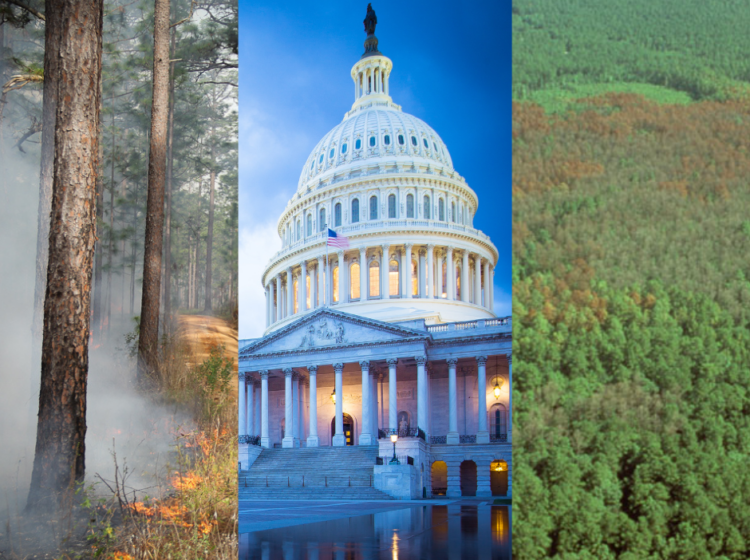Forest & Woodlands Management
Approximately 86% of the South’s forestland is privately-owned, making it the nation’s stronghold for private forestland ownership.
The South has more than 245 million acres of forestland with some of the most diverse and productive ecosystems in the world. Southern state forestry agencies work primarily with family forest owners on private forest land.
Forest and woodland owners understand that sustainable forest management and climate-smart forestry practices are vital. By maintaining healthy forests, landowners are also protecting air, water, habitat, natural beauty, community health and more – all while safeguarding the long-term economic viability of their lands.
Recent News
View AllWhy southerners own their woods
Southern state forestry agencies give technical guidance to landowners on how to manage their forests and woodlands, based on what’s important to them.
The top five objectives identified by landowners in the Southeast include:
- Beauty or scenery
- Wildlife habitat
- Privacy
- Nature protection
- Water protection
Other priority objectives include family legacy, land investment, hunting, recreation and timber products.
Local Assistance
Sustainable working forests
Working forest owners manage for the long-game – replanting and growing back the same amount that was harvested (or more) every year, in perpetuity.
Working forests are timberlands, mostly privately owned in the United States, which are actively managed for multiple uses. These privately-owned forests support the production of renewable products like lumber, paper products, bio-energy and thousands of consumer goods and other everyday items.
According to the National Alliance of Forest Owners, private forest owners regenerate an average of 43% more wood than they harvest. By maintaining healthy working forests, landowners also protect air, water, habitat, natural beauty, community health and more.
Encouraging timber growth and reforestation
Recognizing that growing timber is a long-term, often high-risk investment, the federal government offers tax incentives to private, non-industrial landowners to encourage them to grow timber and reforest lands after timber harvest.
The reforestation tax credit and amortization provisions are one of the few long-term incentives available to landowners for growing trees.
Timber Tax Resources
Forest Management Support Programs
Conservation Easements
State forestry agencies help private landowners access forest conservation opportunities, such as the Forest Legacy Program, which help landowners protect private forestlands via conservation easements or land purchases. Conservation easements allow landowners to maintain rights to manage their forests for timber, as well as other personal and financial benefits, while ensuring the land remains forested into the future. The benefits of conservation easements can also extend to heirs, as reduced estate taxes can make it easier and more affordable to keep the land in the family.
Cost-share Programs
The Farm Bill includes several forestry cost-share and assistance programs for landowners. These programs are available through cooperative partnerships of state forestry agencies, the USDA Natural Resources Conservation Service (NRCS) and the USDA Farm Services Agency. For information on additional forest management incentives programs, contact your local state forestry agency.
Forest Certification Programs
While sustainable forest management has always been a priority of forest owners, the development of forest certification programs in recent decades has provided an opportunity to validate to the public, and those sourcing wood products, that their forests are responsibly managed. Demand is growing, especially in many international markets, for certification of a wide range of wood products – from paper to bio-energy. Approximately 36.3 million acres of southern forests are certified to at least one of three domestic forest certification programs.
Tackling forest health threats
The spread of forest pests, diseases and invasive species persistently threatens the health and survival of southern forests.
Forest insects account for 20% of the total negative growth impact on forest trees, while diseases account for 45%. Among significant non-native insects and diseases established in the South are the hemlock woolly adelgid, spongy moth, emerald ash borer, laurel wilt disease and Asian longhorned beetle. Monitoring and suppression are important tools for preventing and managing these pests.
State forestry agencies work directly with private landowners to educate them about ongoing and evolving forest health threats, while helping them develop plans to manage for and prevent outbreaks. By engaging with landowners, we are better equipped to find and stop threats before they spread.
Learn More
Resources
Keeping Forests
Keeping Forests is a partnership initiative focused on conserving southern forests by supporting private landowners, shedding light on why this land matters and showing what you can do to help.
Healthy Forests Reserve Program (HFRP)
The Healthy Forests Reserve Program (HFRP) helps landowners restore, enhance and protect forestland resources on private and tribal lands through easements and financial assistance.
Environmental Quality Incentives Program (EQIP)
The Environmental Quality Incentives Program (EQIP) is NRCS’ flagship conservation program that helps farmers, ranchers and forest landowners integrate conservation into working lands.
Southern Pine Beetle Prevention Program
The Southern Pine Beetle Prevention Program is a cost-share and incentive program for mix of forest management practices to prevent Southern Pine beetle.
SGSF Forest Certification Programs
A SGSF publication to provide information about major forest certification programs operating in the United States, specific aspects of each and their impact on southern forest management systems.
Don’t Move Firewood
Don’t Move Firewood is an outreach partnership managed by The Nature Conservancy, to protect trees and forests from invasive insects and diseases that can travel in or on contaminated firewood.
The Southern Forest Futures Project
The Southern Forest Futures Project provides an evaluation of the implications of potential futures for goods and services provided by southern forests.
Planning for the Future of Southern Forests
Summary analysis identifying themes, approaches and methods used to develop statewide forest resource assessments and strategies in the South.
#forestproud
#forestproud is a cutting-edge communications initiative building awareness and support for forest climate solutions among 18-34 outside the forestry sector.
Healthy Trees, Healthy Lives
Healthy Trees, Healthy Lives is an outreach initiative highlighting the connection between human health and trees.
The Forest Water Relationship
More information coming soon!
Visit My Forest
Exposure to forests and trees helps decrease mental fatigue by relaxing and restoring the mind, while boosting serotonin levels to improve energy and mood. Take a forest break!


